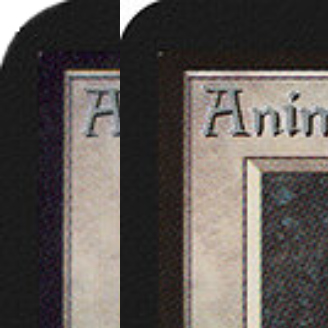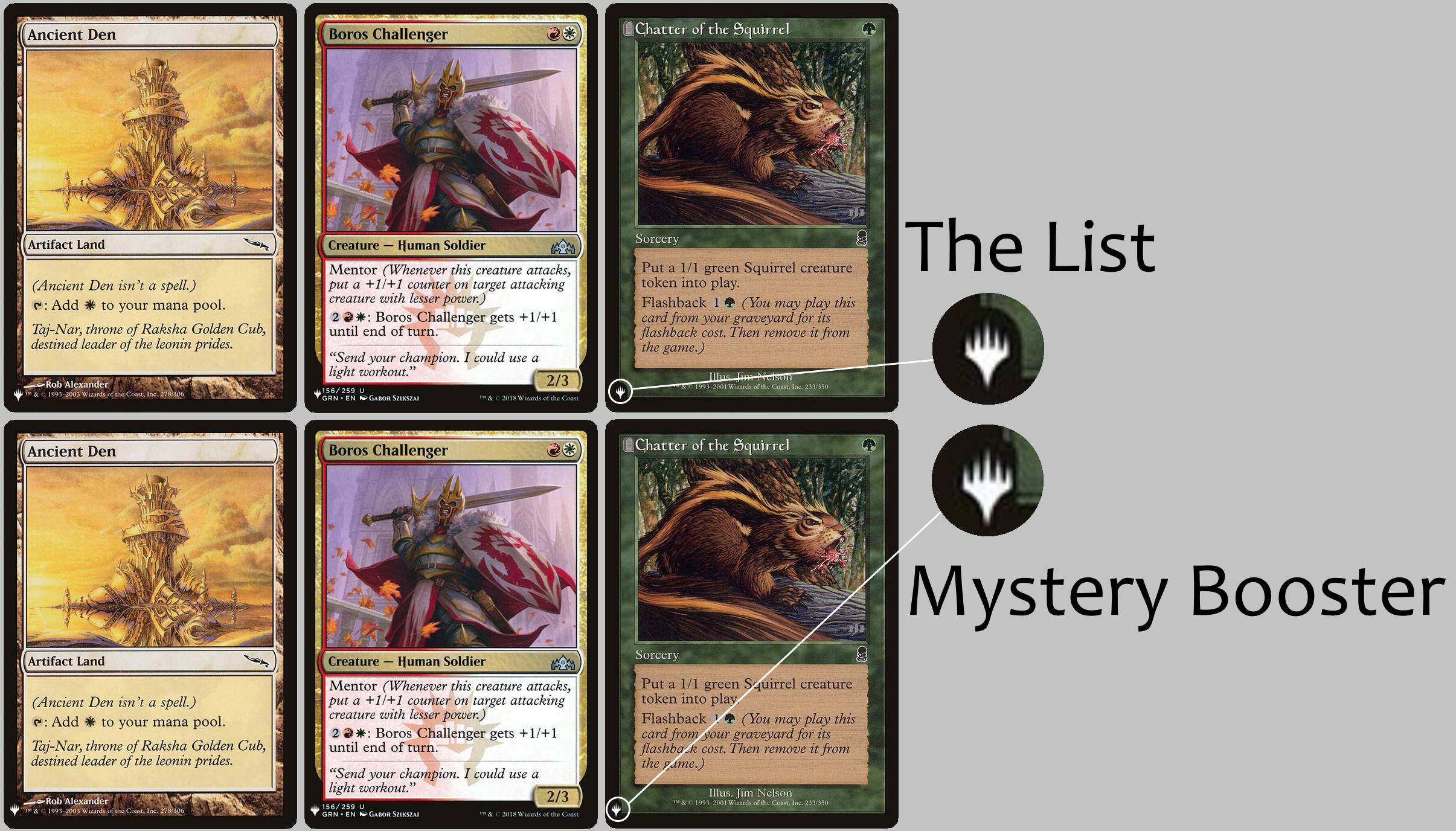Commonly Confused MTG Sets
While some Magic the Gathering expansion sets are readily identifiable, some are really, really, really easy to mistake for one another.
Most of the sets we’re going to talk about today are reprints and a couple are from the earliest days of MTG, before Wizards of the Coast realized people would care which set a card was from.
No Expansion Symbol
Alpha vs. Beta
Limited Edition Alpha and Limited Edition Beta cards both have distinct white triangles in their borders and have no legal or collector’s information other than the illustrator’s copyright. When it comes to identifying the difference between an Alpha card and a Beta card, you just have to compare the corners to any Magic card with a set mark. If those corners don’t match, congratulations, you’re probably holding a card from Magic’s very first printing. If they do match, that card is probably from Beta.
In both of these images, the card on the left is the Alpha printing of Animate Wall, whereas the card on the right is from Beta.
Revised vs. Unlimited
Cards from both Unlimited and Revised sets have a white border and no legal information other than the Illustrator’s copyright.
The easiest way to tell the difference between these two sets is by their inner border. Revised cards have a flat black line whereas Unlimited cards have a beveled inner border that looks like their black-bordered original printings in Alpha and Beta. Additionally, the card’s name is much closer to the border on an Unlimited card, whereas the artist’s name will be much higher.
In this image, the card on the left is an Unlimited copy of Animate Wall. The card on the right is from Revised.
Summer Magic
This set looks a lot like Revised and Unlimited. There’s one key difference: the cards are all copyright 1994.
Fifth Edition
Also white-bordered and missing a set mark, these cards are readily identified by their copyright date: 1997.
Fourth vs. Alternate Fourth
These cards all have white borders, no set mark, and are copyright 1995.
Alternate Fourth Edition doesn’t officially exist (these cards never made it to mass production and weren’t distributed intentionally) and most collectors don’t know about it. There’s a pretty significant value jump between Fourth and Alternate Fourth for some of the collectors who do know about it, so it may be worth your time to double check none of these cards are in your collection.
It’s mostly identifiable by the things that make it a little bit off. The texture is different, the colors are different (they fail the dot test), they’re glossier, and they glow under a black/UV light. Comparing the top of the “A” in Magic on the back of the card will also help. On Alternate Fourth cards, the “A” is much, much darker.
The card on the left is a regular Fourth Edition Magic Card. The Card on the right is Alternate Fourth.
Reprints
Chronicles
This set is a reprint of cards from Arabian Nights, Antiquities, Legends, and The Dark. Basically, if it has any of those set marks, is copyright 1995, and has a white border, then it’s from Chronicles.
Anthologies
Released as part of Wizards’ fifth anniversary celebration, this box set reprinted cards from every magic expansion that existed at the time. The key to identifying these cards is their white border combined with their copyright date: 1993-1998.
Battle Royale
This box set was a reprinting of some of the sets that were in Chronicles (Arabian Nights, The Dark) and a whole smorgasbord of others - 15 different sets were included. The key to identifying a Battle Royale card is a white border and copyright dates 1993-1999. If there is a card number below the text box, it’s not from Battle Royale.
The List vs. Mystery Booster
First, a tiny bit of history: Wizards introduced Mystery Boosters in fall of 2019, with the Convention Edition then followed up with a release of Retail-Exclusive packs in spring of 2020. The good news is that there’s no reason to worry about whether cards are from the Retail or Convention versions because where the set overlaps, no one cares which packs they’re from, and the cards that are exclusive are only listed as those exclusives. Cards from both the Retail- and Convention-Exclusive packs are identifiable by a white planeswalker symbol in the bottom left corner of the card. When set booster packs were introduced in fall of 2020, Wizards started including cards from The List. These cards, all of which are reprints, also feature a white planeswalker symbol in the bottom left corner of the card.
The general consensus among online sellers right now is that there’s no reasonable difference between the cards and they sell them as the same thing. Collectors seem to have also bought into this rationale and, for all intents and purposes, if a card exists with the same art and set symbol on both set lists, there’s no real reason to figure out which version you’re holding. There’s could change in the future and collectors ten years from now may be paying a premium for one version or the other.
If the shape around the Planeswalker symbol is tighter and more square shaped, you’re holding a Mystery Booster Card.
THAT SAID, old-border cards which were printed in both The List and Mystery Boosters are visibly different. The graphic they added to the Mystery Booster packs had a square background, and the one they used for The List seems to have a rounded background, which creates a telltale difference in the shape of the card’s border as you can see on Chatter of the Squirrel and Ancient Den as well as subtle changes in its placement on new border cards, as seen on Boros Challenger.
Duel Decks vs. Duel Decks Anthology
Some of these expansion symbols look really similar to the sets they borrow cards from, some don’t. All of the cards from the Duel Decks are reprints (a couple did get exclusive alternate art) but their unique set symbols should get you where you need to go. Unfortunately, Duel Decks Anthology cards are reprinted versions of other Duel Decks and they share a set symbol so you’ll also need to look for a copyright date. If it’s copyright 2014, it’s a Duel Decks Anthology card.
The copy of Harmonize on the left is from Duel Decks: Garruk vs. Liliana (DD), whereas the copy on the right is from Duel Decks Anthology: Garruk vs. Liliana (GVL).
Since figuring out which of these decks is which can be a little time consuming, here’s every duel deck with its corresponding expansion symbol:
Overwhelmed?
Don’t worry! Starting out as a new collector means there’s a lot to learn and we know exactly how confusing it is.
We’ve got you covered with our complimentary appraisal and identification services. We’ll tell you exactly what you have and whether it’s worth anything free of charge.
Be sure to follow @alatomtcg on your preferred social platforms and Join our discord community where you can buy, sell, trade, and discuss all your favorite trading card games!














